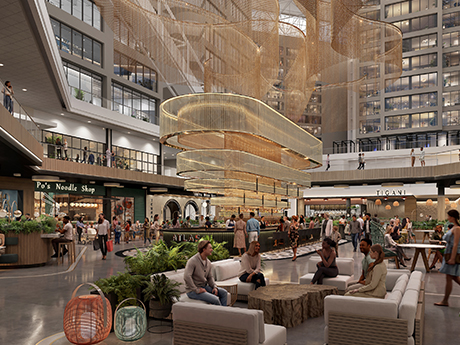If you’ve spent any time driving around Atlanta recently, you’ve probably noticed something. More development sites are returning with bulldozers and developers are taking down land parcels in the suburbs the size of small European countries. But this time, the approach is more strategic than ever.

Gone are the days when a developer would carve out a shopping center for base rents less than $40 per square foot and call it a day. Today, some metro Atlanta developers are assembling larger tracts and creating hybrid projects that include multifamily housing, storage and even industrial uses in the back of the parcel, saving the front-facing road frontage for ground leases, build-to-suits and limited shop space. Automotive and restaurants concepts are clamoring for pads.
The result? Those once-overlooked “front and center” pad sites and strip centers are suddenly the belle of the ball. The downside is paying too much on the buy side for the dirt for aggressively low caps rates. But all I can say for the rental rates that I’m seeing is “Wow.”
Restaurants still lead
In Atlanta’s retail market, restaurants continue to be the leading driver of leasing activity. According to observations, excluding junior box space, food-and-beverage deals made up a significant portion of new retail leases signed in the metro area. This isn’t surprising as suburban families, empty nesters and millennials alike are seeking dining experiences that feel like a “third place” between home and work, preferably much closer to home.
It’s why projects like Halcyon, The Battery, Chattahoochee Food Works and other local food halls have set the standard for restaurant-heavy developments, especially along the BeltLine. Developers from Milton to Midtown to McDonough are following suit, banking on the fact that people will drive (or Uber) for great food and good vibes even if traffic tries its best to convince them otherwise.
Adaptive reuse gets creative
Not every project requires starting from scratch. Adaptive reuse has taken hold across Atlanta and the suburbs, transforming excess land and buildings to retail destinations. Take The Works in Upper Westside or Ponce City Market’s ongoing expansion, The Center (formerly CNN Center) and the Atlanta BeltLine. These projects show how authenticity and history can be an amenity, with developers realizing that diners would rather sip craft cocktails in a century-old brick building than a beige stucco box with fluorescent lighting.
The trend is also sneaking into the suburbs, or locally OTP (outside the perimeter). Brokers are seeing increasing demand for adaptive reuse opportunities throughout the Atlanta market to mimic places like Canton Street in Roswell, the Marietta Square, downtown Duluth, Woodstock and Alpharetta — or emulating intown neighborhoods including Decatur, Virginia Highlands, O4W (Old Fourth Ward) and Inman Park — where older buildings can be reimagined into chef-driven restaurants, boutique retail or entertainment concepts.
Suburban town centers
If the pandemic taught us anything, it’s that people like being closer to home. That realization is fueling a renaissance in suburban town centers. Again, places like Canton Street in Roswell, Halcyon in Forsyth County and Downtown Woodstock are thriving because they provide walkable environments where families can grab dinner, shop and maybe listen to live music, all without trekking intown and look at the skyrocketing single-family homes, condos and rental prices within walking distance to those developments.
Investors are taking notice. According to a myriad of reports, Atlanta’s retail vacancy fell into the 4.4 percent range in second-quarter 2025, one of the lowest rates in the Southeast. Compare that to traditional malls, many of which are still struggling to find their footing, and you’ll understand why money is flowing into suburban mixed-use redevelopments along with strip centers and pad sites.
A broker’s perspective
Brokers will tell you that competition for second-generation restaurant space is fierce. A former 2,300-square-foot casual dining spot in Buckhead will receive multiple LOIs (letters of intent) in the first week it hits the market. Why? Because construction costs for ground-up restaurant space are through the roof. Restaurant operators want a space where there’s a hood, 400+ amps of power, upgraded HVAC and the grease trap is already in place.
At the same time, national chains and local restaurateurs alike are looking for density, traffic, visibility, parking and of course disposable income. That’s why those front-and-center retail strips along major arteries on the northside of Atlanta are commanding premium rents.
Some negative
Of course, no Atlanta retail story would be complete without mentioning our unique quirks. Parking ratios remain a blood sport. Meanwhile, restaurateurs are still trying to figure out if Atlantans like patios or rooftop decks (sexy but typically underutilized) or if we just like the idea of patios until July humidity turns them into Bikram yoga studios. Or you’re inhaling exhaust and listening to tricked out mufflers instead of your friends over dinner.
Also, beware of hot markets that explode overnight, and everyone rushes in to pay above-market rents then they find out that lunch traffic is minimal or there are eight other new breakfast concepts within a three-minute walk. One daypart, traffic and the annoying search/cost to park will keep operators up at night and possibly in debt.
Where it’s all heading
Looking ahead, the mix of concepts on three- to five-acre parcels is likely to accelerate. Expect to see even more projects that tuck multifamily, self-storage, industrial or flex space behind a strong quick-service restaurant (QSR) or fast-casual brand with frontage.
Investors like the diversified income streams, developers like the scale and cities like the added density and income. I also expect to see more QSRs coming available from concepts that failed to evolve or attempted to too late. The allure of the drive-thrus with no indoor or minimal seating and smaller footprints is proving successful for some.
In short: the Atlanta retail and restaurant scene is more dynamic and diversified than ever. While deals proceed at a grueling pace, whether it’s adaptive reuse, suburban town center redevelopments, food halls or good old-fashioned strip centers with strong road presence, the opportunities are abundant.
For brokers, developers, investors, and operators alike, retail/restaurants in Atlanta is alive and well yet very market specific; In many areas paid parking has become a money grab and it’s occasionally how efficient you are in finding a parking space and scan the QR code (that you pray is legit) once you get there.
— By Alan Shaw, executive vice president of TSCG. This article was originally published in the October 2025 issue of Southeast Real Estate Business.


